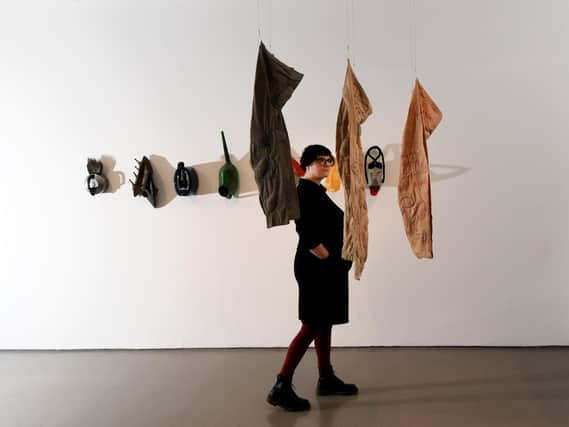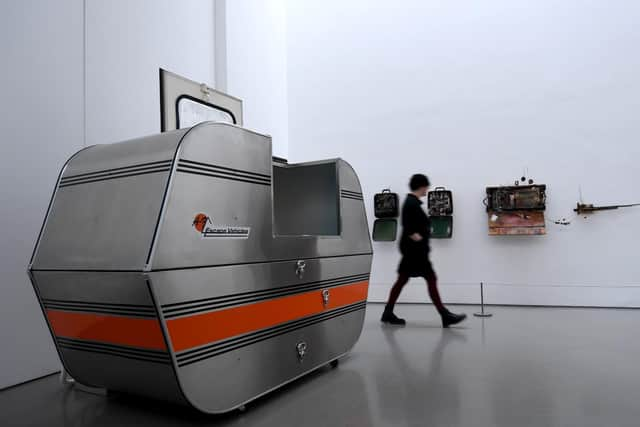Henry Moore Institute brings new portable sculpture exhibition with work by Marcel Duchamp to Leeds


The last century and this one (thus far) have been broadly characterised by unstable geopolitics, conflict and far-reaching economic change and the consequences of these have both impacted upon and been reflected in the art of the time. The related themes of impermanence and instability, home and identity, migration and travel are being explored in a new exhibition which opens at the Henry Moore Institute in Leeds this month.
Portable Sculpture brings together the work of 15 artists – including Marcel Duchamp, Louise Bourgeois, Alexander Calder, Hannelore Baron, Mohamad Hafez, Do Ho Suh and Veronica Ryan – showcasing work from 1934 to the present day and presenting specially commissioned new work by James Ackerley and Claire Ashley.
Advertisement
Hide AdAdvertisement
Hide Ad“The concept behind the show has been percolating for a long time,” says curator Clare O’Dowd.


“A lot of the ideas in the exhibition came about through my PhD research and conversations with artists over the years. My research specialism is 20th century sculpture and I’m interested in the effect of the Second World War and how many of those artists were having to flee Europe. Duchamp had to leave and go to New York, for example. I became interested in what was important to people when they were forced to leave their home. That was the starting point.”
O’Dowd also looked at contemporary contexts and situations where artists found themselves in a position of uncertainty or instability and how that would affect the way in which they make their work. “It’s about artists rising to different challenges,” she says. “When we first started planning the exhibition there were obviously a lot of resonances with geopolitical situations and conflict around the world but during the planning Covid-19 happened. That obviously had an impact and also completely changed the way we put things together.”
Impermanence, instability and unpredictability suddenly became part of everyone’s daily life and so since its inception the exhibition has taken on a deeper relevance.
Advertisement
Hide AdAdvertisement
Hide AdThe Institute’s close relationship with its next-door neighbour on the Headrow was helpful as the curatorial team selected pieces to include in the exhibition.
“We were really lucky that Leeds Art Gallery has many wonderful works in its collection that we can draw on,” says O’Dowd. “Also, there were a lot of sculptures over the years that I had mentally classified as being somehow portable. One of the things I wanted to demonstrate in the exhibition was that portable doesn’t necessarily have to mean small. I wanted to choose some really large-scale works that could be easily transported but would be huge in the gallery.”
The work of Claire Ashley is a fine example of that. The Scottish-born, Chicago-based artist creates monumental inflatable sculptures that take up a lot of space but are designed to pack down small.
“The work that Claire made especially for the exhibition arrived in something the size of a gym bag,” says O’Dowd. “She made it so that it can be folded into its own travelling bag.”
Advertisement
Hide AdAdvertisement
Hide AdAshley first began making her inflatable pieces in 2007 and they are an intriguing combination of sculpture, performance art and painting. “They essentially came out of me having three kids in quick succession in the early 2000s,” says Ashley. “I had been thinking about how I could make monumental work that could be movable by me as a fiercely independent person.”
Using bright colours, Ashley’s work is playful, mischievous and provocative. The inflatables recall cuddly toys, bouncy castles and soft play areas but fundamentally they are interrogating accepted ideas of what sculpture – and painting – can be.
“I like the fact that embedded within these pieces is my tongue-in-cheek relationship to monumental sculpture and serious abstract impressionist painting,” she says. “It meant I could be critical of the idea of sculpture as being static and painting as just sitting on the wall behaving itself – I could misbehave and move them around the landscape. I think of them as strange, mangled Darwinian creatures, beings that are evolving somehow.”
Humour is a key aspect and Ashley sees it as an important tool in making it as accessible to as many people as possible. “I’m really interested in physical humour and slapstick. I like the idea that I am making something that is literally full of hot air but I’m also grounding it at the same time.”
Advertisement
Hide AdAdvertisement
Hide AdMuch of the work on display in the exhibition is from artists O’Dowd has worked with in the past and she also specifically selected some of the pieces for the stories associated with them.
“One of the artists in the show, James Ackerley, made his work portable because for a long time he didn’t have a permanent studio space – he was moving around a lot and it was necessary for him. Veronica Ryan is interesting – almost all her body of work relates to movement, travel and migration and she references her own story in it.”
She was born in Montserrat in the Caribbean and now lives between New York and London. “She uses seeds from tropical plants and charts their movement across the world. A big part of the exhibition is trying to tell the stories beyond the artworks, some of which are very personal but others are to do with broader issues in the contemporary world.”
Also featured in the exhibition is work by Mohamad Hafez who was born in Damascus, trained as an architect in Saudi Arabia and is now based in the United States. Much of his work explores the feelings of homesickness he was experiencing, even before the civil war began in Syria eight years ago.
Advertisement
Hide AdAdvertisement
Hide Ad“The war meant that he couldn’t go back home, so he started making these little models as a kind of therapy for missing home.” Hafez creates miniature architectural models – subjects include bombed out buildings and tent cities – which are then displayed in suitcases that are hung on gallery walls. “He wants to highlight the effect of conflict on people – he talks about the emotional baggage that people carry with them and many of the suitcases have been given to him by refugees and migrants,” says O’Dowd.
The work of Hannelore Baron is also related to displacement. Her family fled Nazi Germany when she was a young teenager, eventually settling in New York. She is known for the highly personal book-sized abstract collages and box constructions that she began creating in the 1960s.
O’Dowd and her team are looking forward to welcoming people back to the gallery. “We can’t wait for the doors to open and for people to experience the exhibition,” she says.
“It can work on many different levels – people will be able to see these extraordinary objects, beautiful and innovative sculptures but also reflect on the stories behind them. I think in terms of post-Covid recovery, art galleries, museums and cultural institutions of all sorts are going to be essential.”
Portable Sculpture opens at the Henry Moore Institute on May 18 and runs until August 29. www.henry-moore.org